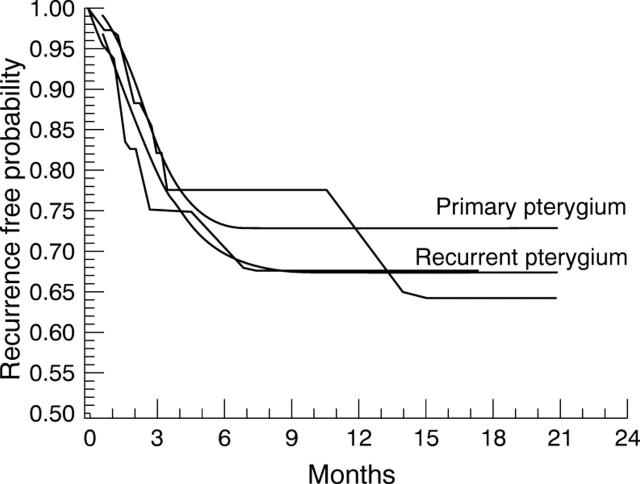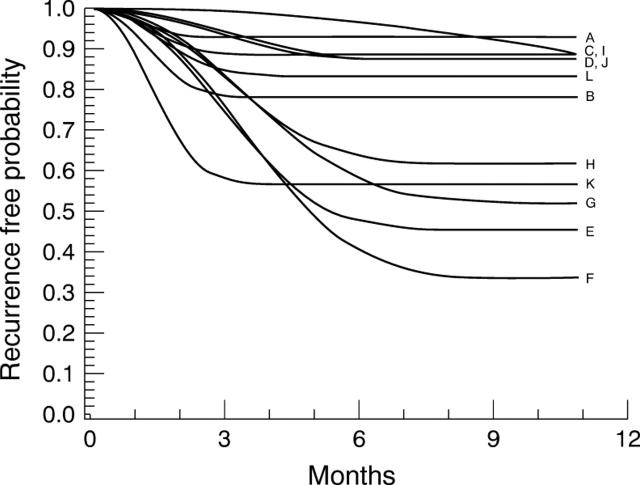Abstract
AIMS—To evaluate the success rates of conjunctival autografting for primary and recurrent pterygium performed in a tertiary ophthalmic centre. METHODS—The outcome of 139 cases with primary pterygia and 64 cases with recurrent pterygia who underwent excision with conjunctival autografting was retrospectively reviewed. Outcome was evaluated in terms of recurrence of pterygia onto the cornea. The recurrence rates were determined using Weibull survival functions, in a mixture model that included a component allowing for cure. The suitability of this model was verified using Turnbull's non-parametric method for interval censored data (1974). Estimated recurrence free probabilities were based on the fitted Weibull survival curves. RESULTS—Mean follow up was 8.4 months in the primary group, and 9.5 months for the recurrent group. 29 out of 139 cases of primary pterygia recurred (20.8%) while 20 out of 64 cases in the recurrent group (31.2%) recurred. Recurrence rates varied widely among surgeons, ranging from 5% to 82%. Recurrence rates were inversely related to previous experience in performing conjunctival grafting. The recurrence free probability was 84% at 3 months, 73% at 1 year for primary pterygia, and 80% at 3 months, 67% at 1 year for recurrent pterygia. There was no statistical difference in recurrence rates between primary and recurrent groups (p= 0.80). CONCLUSION—The success of conjunctival autografting for pterygium in this series varies widely, and may be related to a significant learning curve or differing surgical techniques for this procedure. This may account for the wide variation in reported success of this procedure in the ophthalmic literature.
Full Text
The Full Text of this article is available as a PDF (108.8 KB).
Figure 1 .
Ordinary lines show recurrence free survival for primary pterygium, bold lines for recurrent pterygium. The irregular lines are estimates derived using Turnbull's method, while the smooth curves are Weibull distributions fitted to the same data, incorporating a proportion of the patients who never have a recurrence.
Figure 2 .
Each curve is a Weibull distribution fitted to the recurrence free times of patients operated on by one surgeon. Only surgeons who contributed at least eight eyes to the data are included.
Selected References
These references are in PubMed. This may not be the complete list of references from this article.
- Chen P. P., Ariyasu R. G., Kaza V., LaBree L. D., McDonnell P. J. A randomized trial comparing mitomycin C and conjunctival autograft after excision of primary pterygium. Am J Ophthalmol. 1995 Aug;120(2):151–160. doi: 10.1016/s0002-9394(14)72602-9. [DOI] [PubMed] [Google Scholar]
- Dunn J. P., Seamone C. D., Ostler H. B., Nickel B. L., Beallo A. Development of scleral ulceration and calcification after pterygium excision and mitomycin therapy. Am J Ophthalmol. 1991 Sep 15;112(3):343–344. doi: 10.1016/s0002-9394(14)76738-8. [DOI] [PubMed] [Google Scholar]
- Hayasaka S., Noda S., Yamamoto Y., Setogawa T. Postoperative instillation of low-dose mitomycin C in the treatment of primary pterygium. Am J Ophthalmol. 1988 Dec 15;106(6):715–718. doi: 10.1016/0002-9394(88)90706-4. [DOI] [PubMed] [Google Scholar]
- Hirst L. W., Sebban A., Chant D. Pterygium recurrence time. Ophthalmology. 1994 Apr;101(4):755–758. doi: 10.1016/s0161-6420(94)31270-x. [DOI] [PubMed] [Google Scholar]
- Kenyon K. R., Wagoner M. D., Hettinger M. E. Conjunctival autograft transplantation for advanced and recurrent pterygium. Ophthalmology. 1985 Nov;92(11):1461–1470. doi: 10.1016/s0161-6420(85)33831-9. [DOI] [PubMed] [Google Scholar]
- Lewallen S. A randomized trial of conjunctival autografting for pterygium in the tropics. Ophthalmology. 1989 Nov;96(11):1612–1614. doi: 10.1016/s0161-6420(89)32667-4. [DOI] [PubMed] [Google Scholar]
- MacKenzie F. D., Hirst L. W., Kynaston B., Bain C. Recurrence rate and complications after beta irradiation for pterygia. Ophthalmology. 1991 Dec;98(12):1776–1781. doi: 10.1016/s0161-6420(91)32051-7. [DOI] [PubMed] [Google Scholar]
- Riordan-Eva P., Kielhorn I., Ficker L. A., Steele A. D., Kirkness C. M. Conjunctival autografting in the surgical management of pterygium. Eye (Lond) 1993;7(Pt 5):634–638. doi: 10.1038/eye.1993.146. [DOI] [PubMed] [Google Scholar]
- Rubinfeld R. S., Pfister R. R., Stein R. M., Foster C. S., Martin N. F., Stoleru S., Talley A. R., Speaker M. G. Serious complications of topical mitomycin-C after pterygium surgery. Ophthalmology. 1992 Nov;99(11):1647–1654. doi: 10.1016/s0161-6420(92)31749-x. [DOI] [PubMed] [Google Scholar]
- Tan D. T., Chee S. P., Dear K. B., Lim A. S. Effect of pterygium morphology on pterygium recurrence in a controlled trial comparing conjunctival autografting with bare sclera excision. Arch Ophthalmol. 1997 Oct;115(10):1235–1240. doi: 10.1001/archopht.1997.01100160405001. [DOI] [PubMed] [Google Scholar]
- Youngson R. M. Recurrence of pterygium after excision. Br J Ophthalmol. 1972 Feb;56(2):120–125. doi: 10.1136/bjo.56.2.120. [DOI] [PMC free article] [PubMed] [Google Scholar]




